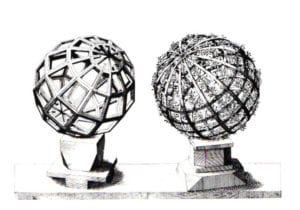Art and Technics Wenzel Jamnizer by Curtis Lafollette 1992 Spring Metalsmith
This article is one of a serial of manufactures from Metalsmith Magazine "Art and Technics" talking near techniques in craftsmanship and design. For this 1991 Spring issue, Curtis Thousand. LaFollette talks about Wenzel Jamnizer.
~~~~~~~~~~~~~~~~~~~~~~~~
On Oct 12, 1984, I was attending a briefing on mathematics, "Visualizing Higher Dimensions," at Dark-brown University. Equally I was nearly to enter Sayles Hall to hear a paper presented by Rudy Rucker on "The Further Adventures of A Square", a colleague handed me a stack of photocopies with illustrations of some of the weirdest geometry I had ever encountered. That was my introduction to Wenzel Jamnizer (1508-1585). Equally I examined the reproductions later that day, it became clear why they had been given to me. A number of the ideal solids had been skeletonized, so that as his text describes them they were "see-throughable." These engravings diameter an eerie resemblance to the neoconstructivist sculpture I was producing in steel and aluminum at that time.
I wanted to know more than, but the text was in an archaic southern High german dialect. Fortunately, Professor Bob Warnock from Brownish Academy was familiar with the dialect and provided me with invaluable translations. Information technology was then possible for me to evaluate Jamnizer'south contributions to the Northern Renaissance.
Wenzel Jamnizer was born in Vienna merely moved in 1534 to Nurenberg, where he became a chief goldsmith. He executed many praiseworthy commissions For the High german Majestic Court and was particularly adept at the production of high relief on vessels through the use of repoussé. He was respected every bit a chief among masters at a time when Nurenberg was the preeminent centre for goldsmithing in the German-speaking principalities. He was also instrumental in the development of the table clock, a 16th-century German innovation. In addition, he was a skilled bronze caster who maintained the continuity of the German tradition of sculpture until the mid-century marker when he began to adopt the court mannerist fashion typical of about of the rest of Europe. He too adult a reputation, as Albrecht Durer had before him, as a cracking theorist, sharing in the evolution of the intellectual life of northern Europe. He was as interested in Euclidean geometry, which had disappeared from the European consciousness during the Middle Ages, and Perspective, the quintessential development of the Renaissance.
The development of perspective can be traced all the way dorsum to the 11th century, when Alhazen, a mathematician, writing in Toledo, recognized the fundamental mistake of Ptolemaic perception theory. Different Ptolemy, he states correctly that light reflects from an object to the eye, whence it is perceived. Alhazen's Optics was translated by Lorenzo Ghiberti in the 15th century and the foundation for perspective was laid. Alberti published Della Pittura in 1435, and Piero della Francesca followed in nigh 1482 with his De Prospectiva Pingendi. In 1506 Durer traveled to Italy to learn "the secret art of perspective" from the study provided by these Renaissance masters.
-

- Wenzel Jamnizer, "see-throughable" globes, 1568
Durer (1471-1528) was some other Nurenberger who had studied goldsmithing earlier he became a printmaker and painter. He had reached the top of his esthetic and intellectual power while Jamnizer was nevertheless working to become a master. Durer'south work in perspective was published posthumously in 1532, the same year Jamnizer achieved his main status.
With the publication of Perspectiva Corporum Regularium in 1568, Jamnizer demonstrates his mastery of geometry and perspective. While he uses conventional mathematical procedures of truncation and stellation, he transcends the production of unproblematic mathematical models in the innovative manner he applies the processes. He has likewise succeeded in creating a strong dynamic tension between the implied kinetic free energy of the figures and the stability of their bases.
Perhaps the most eccentric of these figures are the "run into-throughable" globes, 2 of which are reproduced here. The one on the left is a masterful rendering of structural elements. Most interesting is the suspension of the structure every bit elements converge at the poles, creating an opportunity for some visual variety as well as a better look at the within of the form, while at the same fourth dimension clearly violating the purity of the mathematical model. The figure on the right reflects an e'er greater deviation from mathematics. A foreign batter of latitudes and longitudes trellising biomorphic vines, it is totally unclassifiable.
In that location were others who connected to tinker with the Jamnizer perspective appliance, and those who continued to develop mathematical objects in and around Nurenberg during the 16th century, but no ane else produced a volume of such elegance. Nor was at that place some other work from this period that so succinctly summarized the accumulated cognition of perspective or geometry. Jamnizer remains a significant intellectual and esthetic figure, an exemplary goldsmith.
Thanks to Bob Warnock, a professor in the German Section at Brown University for his translations of the Jamnizer texts.
Curtis K. LaFollette is Professor of Art at Rhode Island College in Providence.
By Curtis Grand. LaFollette
In association with SNAG'due south
![]()
Metalsmith mag, founded in 1980, is an award winning publication and the only mag in America devoted to the metallic arts.
Source: https://www.ganoksin.com/article/art-technics-wenzel-jamnizer/
0 Response to "Art and Technics Wenzel Jamnizer by Curtis Lafollette 1992 Spring Metalsmith"
Post a Comment